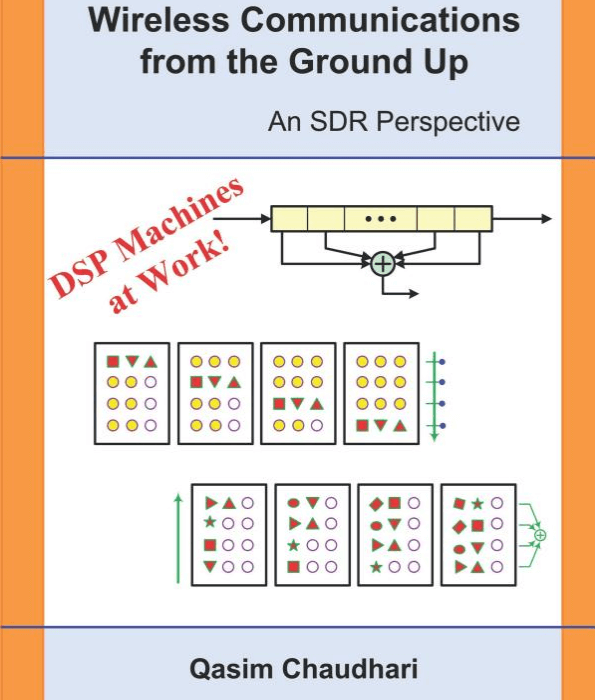New Technical Textbook on SDR and Communications: “Wireless Communications From the Ground Up – An SDR Perspective”
Thanks to author Qasim Chaudhari for writing in and sharing with us that his new book titled "Wireless Communications From the Ground Up - An SDR Perspective" has been released. Qasim is a research fellow in the Electronic and Telecommunications Engineering department at RMIT University in Australia and has been giving presentations and talks each month at Cyberspectrum Melbourne for more than 3 years.
His book covers University level wireless communications and digital signal processing (DSP) topics with a focus on SDR. Qasim writes that most DSP books that he's seen in the past were written for professional academics which made them difficult to for other technical (but non-mathematical) persons to understand. You can't explain DSP without equations, but Qasim notes that his book aims to keep the math content at school level only, and with plenty of figures to help with visualization. The description reads:
There are different angles from which this book contributes to the understanding of wireless communication systems from the perspective of a Software Defined Radio (SDR).
- In my opinion, any language, including that of mathematics, is an unnatural mode of communication. For example, I can write the words darwaza, porte, puerta, umnyango, ovi and only certain people will understand what I mean. However, if I show you an image of a door, almost every single person on the planet will immediately get the concept. A figure imprints a massive amount of parallel information in our brains that is much easier to process and recall later. Since a human mind handles images very well, I try to visualize equations through beautiful figures which you will encounter throughout the text with logical and intuitive explanations.
- If you are not a pure wireless communications academic, you would have found that the mainstream textbooks on this topic are filled with heavy mathematical details which makes this field an exclusive membership club for those who can understand several types of frequency variables and their corresponding Fourier transforms, probability and random processes and detection and estimation theories. While this is true for becoming a master, the Software Defined Radio (SDR) revolution and subsequent projects like GNU Radio have made it possible for anyone to sit down and construct their own unique radio by writing code. Many even do not need to know most of the above mentioned topics. All they need to understand is why an algorithm does what it does so that they know how to write its code, or modify it in an even better way. For this purpose, I have only relied on school level mathematics to explain all the concepts. You will not find any e or j of complex numbers here, nor will you encounter any integrals, probability theory and detection or estimation theory. The only things to know are a sine, cosine and a summation as well as a derivative (which I have occasionally used).
- The best books written on implementing digital communication systems using Digital Signal Processing (DSP) algorithms are by fred harris (Multirate signal processing for communication systems) and Michael Rice (Digital communications – A discrete-time approach). As often happens with the grandmasters, they walk on a trail without exactly clarifying it for others. After reading their books, I started to feel that fred harris has mainly focused on `how' of communication systems in an unprecedented detail while Michael Rice has mainly covered `what' of communication systems in his simple and beautiful style. In this process, there were many `why' generated in my mind for which I had to find satisfactory answers. This book is a collection of those simple answers.
- An extra little bonus is a one page summary of the crux of Rx algorithms, clarifying the role of particular parameters in the signal waveform. Most of the algorithm design can be understood by just grasping the concepts on this one page.
A common theme in this text is that some concepts seem easier in time domain and some others are simpler in frequency domain, while their mathematical derivations reinforce the idea. It is fun to grasp a concept covering all three sides. Finally, the book contains a few examples from GNU Radio that explain how to set the parameters in some blocks (e.g., Costas loop, band edge FLL, polyphase clock sync, etc.).
The book is currently available on Amazon, and on Amazon you can see a preview of some pages from the book. Qasim also has a website for the book here.

Carl,
Bought this book. Not for the layman. Disappointed (and $50 poorer).
Definitely still a University level textbook, not for the layman. Would suggest looking at the preview on Amazon first, if the math and content looks too heavy it’s not for you.
The book definitely contains mathematical derivations. However, I found that it is written in a manner that if one keeps skipping the math parts, one can still understand each concept pretty well. I think the author should publish another version for radio hobbyists by excluding those derivations and keeping the rest of the text as it is.
I just ordered this from Amazon and I am anxious to begin reading it. I have greatly enjoyed my exploration of SDRs and all they have to offer, but after 2 years I still feel as though I have only scratched the surface, I have high hopes that this book can help me to go much deeper!Modulation